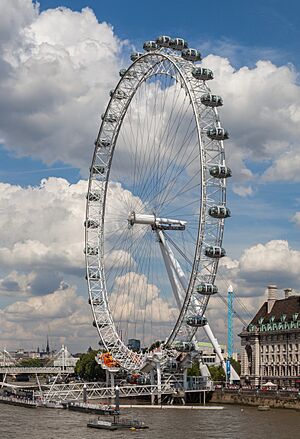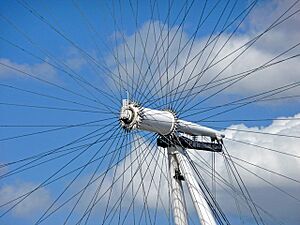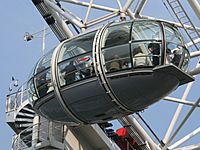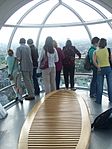London Eye facts for kids
Quick facts for kids London Eye |
|
|---|---|
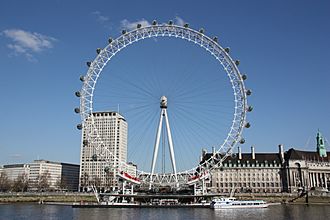 |
|
| Alternative names | Millennium Wheel |
| General information | |
| Status | Operating |
| Type | Observation wheel |
| Location | Lambeth, London |
| Address | Riverside Building, County Hall, Westminster Bridge Road |
| Coordinates | 51°30′12″N 0°07′10″W / 51.5033°N 0.1194°W |
| Completed | March 2000 |
| Opened |
|
| Cost | £70 million |
| Owner | Merlin Entertainments |
| Height | 135 metres (443 ft) |
| Dimensions | |
| Diameter | 120 metres (394 ft) |
| Design and construction | |
| Architect |
|
| Architecture firm | Marks Barfield |
| Structural engineer | Arup |
| Other designers |
|
| Awards and prizes | Institution of Structural Engineers Special Award 2001 |
The London Eye is a giant Ferris wheel in London. It's also called the Millennium Wheel. It's one of the biggest observation wheels on Earth. Lots of people visit it every year, making it the most popular paid tourist spot in the UK. You might have even seen it in movies or TV shows!
The London Eye is 135 metres (443 ft) tall. Its wheel has a diameter of 120 metres (394 ft). When it first opened in 2000, it was the tallest Ferris wheel in the world. Other wheels have since become taller. These include the Sun of Moscow, Star of Nanchang, Singapore Flyer, High Roller in Las Vegas, and Ain Dubai.
Unlike many other tall wheels, the London Eye is supported on only one side. This makes it a "cantilevered" observation wheel. It offered the highest public view in London for many years. Later, the Shard building opened a higher viewing deck. The London Eye is located next to Jubilee Gardens. It sits on the South Bank of the River Thames between two bridges. The closest tube station is Waterloo.
Contents
Building the London Eye
The London Eye was designed by a husband-and-wife team. Their names are Julia Barfield and David Marks. They worked for Marks Barfield Architects.
The outer edge of the wheel is held up by strong steel cables. It looks a lot like a giant bicycle wheel. In 2006, the lights on the Eye were updated. They now use LED lights. This allows for digital control of the lights.
How the Wheel Was Assembled
The wheel was built in many different parts. These parts were floated up the River Thames on large boats. They were put together while lying flat on special platforms in the river. Once the wheel was complete, it was slowly lifted upright. A special system of jacks helped lift it.
The lifting process was very slow. It moved only 2 degrees per hour. It stopped at 65 degrees for a week. This allowed engineers to get ready for the final lift. This project was a big European effort. Parts came from six different countries. For example, the steel came from the UK and the Netherlands. The cables were from Italy, and the bearings from Germany. The capsules were made in France.
Opening and Popularity
The London Eye was officially opened by Prime Minister Tony Blair. This happened on December 31, 1999. However, it didn't open to the public until March 9, 2000. There was a small problem with the capsule system.
The London Eye was first planned to be a temporary attraction. It had a five-year permit to operate. But it became so popular that people wanted it to stay. In 2002, it was given permission to be a permanent landmark. By June 2008, over 30 million people had ridden the London Eye.
Passenger Capsules
The wheel has 32 sealed and air-conditioned capsules. They are shaped like ovals. These capsules are attached to the outside of the wheel. Electric motors make them rotate. The capsules are numbered from 1 to 33. Number 13 is skipped because of superstition.
Each capsule weighs about 10-tonne (11-short-ton). It can hold up to 25 people. Visitors can walk around inside the capsule. There are also seats available. The wheel moves very slowly. It turns at about 26 cm (10 in) per second. This means one full rotation takes about 30 minutes.
The wheel usually doesn't stop to let people on or off. It moves slowly enough for passengers to walk on and off. However, it will stop for people with disabilities or elderly passengers. This ensures everyone can get on and off safely.
Capsule Upgrades and Special Events
In 2009, the capsules started getting upgrades. Each capsule was taken off the wheel. It was then floated down the river for improvements.
On June 2, 2013, one capsule was named the "Coronation Capsule." This was to celebrate 60 years since Queen Elizabeth II's coronation. In March 2020, the London Eye turned 20 years old. To celebrate, some capsules were turned into special themed experiences. These included a pub, a West End theatre, and a garden party inside a capsule.
Getting to the London Eye
The closest London Underground station is Waterloo. Other nearby tube stations are Charing Cross, Embankment, and Westminster. All are within easy walking distance.
You can also reach the London Eye by train. The main train stations nearby are London Waterloo and London Waterloo East station. For those who prefer to travel by water, London River Services boats stop at the London Eye Pier.
Images for kids
-
The Eye on the South Bank of the Thames, with Jubilee Gardens (left) and County Hall (right).
-
The colourful London Eye near County Hall.
See also
 In Spanish: London Eye para niños
In Spanish: London Eye para niños


